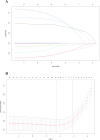Development and validation of a risk prediction model for cognitive impairment in breast cancer patients
- PMID: 39548422
- PMCID: PMC11566113
- DOI: 10.1186/s12888-024-06278-x
Development and validation of a risk prediction model for cognitive impairment in breast cancer patients
Abstract
Background: Breast cancer patients often experience cognitive impairment as a complication during treatment, which seriously affects their quality of life. This study aimed to assess the risk factors associated with cognitive impairment in breast cancer patients and to construct and validate a nomogram model to predict cognitive impairment in this population.
Methods: In this study, we used a convenience sampling method to select 423 breast cancer patients who attended the Department of Breast Surgery at the First Hospital of Jinzhou Medical University from September 2023 to March 2024. We analyzed these patients' cognitive impairment risk factors through LASSO regression and logistic regression analysis to develop a predictive model. The model was evaluated using the area under the curve (AUC) from the receiver operating characteristic (ROC) curve and the calibration curve and decision curve analysis.
Results: This study found a prevalence of cognitive impairment of 19.62% among breast cancer patients. A nomogram model was developed based on six influencing factors: age, educational level, pathological type, treatment program, emotional state, and fatigue. The area under the curve (AUC) for the model's training and validation groups was 0.944 and 0.931, respectively. The model calibration curves showed a high degree of consistency, and the decision curve analysis (DCA) indicated good clinical applicability of the model.
Conclusions: This nomogram demonstrates good discrimination, calibration, and clinical applicability, making it a more intuitive predictor of the risk of cognitive impairment in breast cancer patients.
Keywords: Breast cancer; Cognitive impairment; Nomogram; Risk factors; Risk prediction.
© 2024. The Author(s).
Conflict of interest statement
Figures





Similar articles
-
Development and validation of a dynamic nomogram for predicting cognitive impairment risk in older adults with dentures: analysis from CHARLS and CLHLS data.BMC Geriatr. 2025 Feb 25;25(1):127. doi: 10.1186/s12877-025-05758-3. BMC Geriatr. 2025. PMID: 40000983 Free PMC article.
-
A nomogram for predicting the risk of cancer-related cognitive impairment in breast cancer patients based on a scientific symptom model.Sci Rep. 2024 Jun 24;14(1):14566. doi: 10.1038/s41598-024-65406-5. Sci Rep. 2024. PMID: 38914627 Free PMC article.
-
Establishment, Prediction, and Validation of a Nomogram for Cognitive Impairment in Elderly Patients With Diabetes.J Diabetes Res. 2024 Aug 19;2024:5583707. doi: 10.1155/2024/5583707. eCollection 2024. J Diabetes Res. 2024. PMID: 39188897 Free PMC article.
-
[Establishment and Validation of a Predictive Model for Gallstone Disease in the General Population: A Multicenter Study].Sichuan Da Xue Xue Bao Yi Xue Ban. 2024 May 20;55(3):641-652. doi: 10.12182/20240560501. Sichuan Da Xue Xue Bao Yi Xue Ban. 2024. PMID: 38948266 Free PMC article. Chinese.
-
Development and validation of a dynamic nomogram for high care dependency during the hospital-family transition periods in older stroke patients.BMC Geriatr. 2024 Oct 12;24(1):827. doi: 10.1186/s12877-024-05426-y. BMC Geriatr. 2024. PMID: 39395968 Free PMC article.
Cited by
-
Impact of social support on cognitive function in patients with breast cancer undergoing chemotherapy: The chain-mediating role of fatigue and depression.Asia Pac J Oncol Nurs. 2025 Jun 11;12:100743. doi: 10.1016/j.apjon.2025.100743. eCollection 2025 Dec. Asia Pac J Oncol Nurs. 2025. PMID: 40747250 Free PMC article.
-
Development and validation of a predictive model for depression risk in Chinese obese adults.Front Public Health. 2025 May 14;13:1574386. doi: 10.3389/fpubh.2025.1574386. eCollection 2025. Front Public Health. 2025. PMID: 40438048 Free PMC article.
-
Developing a suicide risk prediction model for hospitalized adolescents with depression in China.Front Psychiatry. 2025 May 2;16:1532828. doi: 10.3389/fpsyt.2025.1532828. eCollection 2025. Front Psychiatry. 2025. PMID: 40386115 Free PMC article.
References
-
- Sung H, Ferlay J, Siegel RL, et al. Global Cancer Statistics 2020: GLOBOCAN Estimates of Incidence and Mortality Worldwide for 36 Cancers in 185 Countries. CA Cancer J Clin. 2021;71(3):209–249. 10.3322/caac.21660. - PubMed
-
- Zheng R, Chen R, Han B, et al. Cancer incidence and mortality in China, 2022. Chin J Oncol. 2024;46(3):221–31. 10.3760/cma.j.cn112152-20240119-00035. - PubMed
Publication types
MeSH terms
LinkOut - more resources
Full Text Sources
Medical

